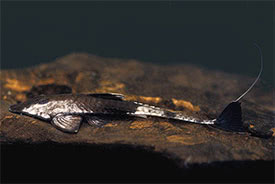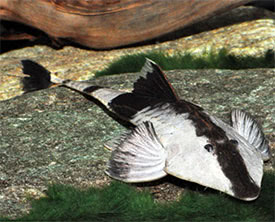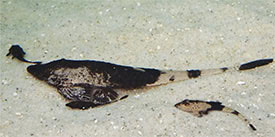
 Magyarul / Hungarian
Magyarul / Hungarian




- Scientific name: Pseudohemiodon apithanos
- Synonyms: -
- Common name: Chameleon Whiptail
- Group: Catfishes
- Habitat: South America; Ecuador and Peru; in San Miguel River basin.
- Size: 18 cm
- Biotope: Found in slow-flowing rivers with sandy substrates where they live between leaves on the bottom of the river.
- Social behavior: Peaceful and not territorial even among it's own kind.
- Diet: Omnivorous; They prefer meaty foods, but will readily accept algae wafers, sinking tablets and other live and frozen foods too.
- Breeding: Very rare in aquarium.
- Tank: Minimum 160 litres
- Population: 4-5 fish for 250 litres
- Decoration: Keep them in a large based aquarium with fine sand bottom, where they can bury themselves. The substrate should be 2,5 cm deep. They usually uproot the plants in the substrate, so the use of floating plants is more practical.
- Temperature: 26-28 °C
- pH: 6.4-7.6
- Hardness: 5-15 NK°
- Lifespan: 8-10 years
Description: A striking and unmistakable catfish, that can change color to almost all black when disturbed. Normally the base coloration can range from a light brown to grey. A dark brown to almost black wide stripe running from the snout, between the eyes to about mid-body, where it forms a dark band on the flank of the fish. There are two more small dark bands along the back, and the tail fin is also black. Their body is flat that tapers toward the tail. The head is triangular, and the small eyes are found on the top of the head relatively close to each other. In the nature this species is also found in light leaf litter over sand, that may provide a clue as to the 'chameleon' attributes of the fish. They usually bury into the substrate during daytime, and come out only to forage during the night.
Mature males will develop whiskers on their lower lips to allow them to carry egg clutches. Their breeding is possible in aquarium, but it is still very rare. During spawning the pair will clear a small area in the substrate, where the female deposits the eggs and the male fertilize them. After this the male collects the large eggs, and keeps them right underneath his head and torso until they hatch. The male carries the eggs for about two weeks before they hatch, and the fry are 1-1.3 cm long, and black in color. They grow very fast in the first month, and later the growth slows down considerably. At three months of age the young fish are 5 cm long, and they start to partially bury themshelves in the sand like the adults, and they start to show more of the chameleon pattern as they age. The Chameleon Whiptail fry are extremely sensitive to water conditions, so weekly 50 percent water changes are essential.










